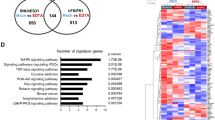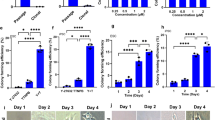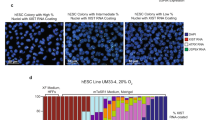Abstract
Poor survival of human embryonic stem (hES) cells after cell dissociation is an obstacle to research, hindering manipulations such as subcloning. Here we show that application of a selective Rho-associated kinase (ROCK) inhibitor1,2, Y-27632, to hES cells markedly diminishes dissociation-induced apoptosis, increases cloning efficiency (from ∼1% to ∼27%) and facilitates subcloning after gene transfer. Furthermore, dissociated hES cells treated with Y-27632 are protected from apoptosis even in serum-free suspension (SFEB) culture3 and form floating aggregates. We demonstrate that the protective ability of Y-27632 enables SFEB-cultured hES cells to survive and differentiate into Bf1+ cortical and basal telencephalic progenitors, as do SFEB-cultured mouse ES cells.
This is a preview of subscription content, access via your institution
Access options
Subscribe to this journal
Receive 12 print issues and online access
$209.00 per year
only $17.42 per issue
Buy this article
- Purchase on Springer Link
- Instant access to full article PDF
Prices may be subject to local taxes which are calculated during checkout



Similar content being viewed by others
References
Ishizaki, T. et al. Pharmacological properties of Y-27632, a specific inhibitor of rho-associated kinases. Mol. Pharmacol. 57, 976–983 (2000).
Hu, E. & Lee, D. Rho kinase as potential therapeutic target for cardiovascular diseases: opportunities and challenges. Expert Opin. Ther. Targets 9, 715–736 (2005).
Watanabe, K. et al. Directed differentiation of telencephalic precursors from embryonic stem cells. Nat. Neurosci. 8, 288–296 (2005).
Lee, S.-H., Lumelsky, N., Studer, L., Auerbach, J.M. & McKay, R.D. Efficient generation of midbrain and hindbrain neurons from mouse embryonic stem cells. Nat. Biotechnol. 18, 675–679 (2000).
Kawasaki, H. et al. Induction of midbrain dopaminergic neurons from ES cells by stromal cell-derived inducing activity. Neuron 28, 31–40 (2000).
Wichterle, H., Lieberam, I., Porter, J.A. & Jessell, T.M. Directed differentiation of embryonic stem cells into motor neurons. Cell 110, 385–397 (2002).
Lindvall, O. & Kokaia, Z. Stem cells for the treatment of neurological disorders. Nature 441, 1094–1096 (2006).
Buytaert-Hoefen, K.A., Alvarez, E. & Freed, C.R. Generation of tyrosine hydroxylase positive neurons from human embryonic stem cells after coculture with cellular substrates and exposure to GDNF. Stem Cells 22, 669–674 (2004).
Li, X.-J. et al. Specification of motoneurons from human embryonic stem cells. Nat. Biotechnol. 23, 215–221 (2005).
Perrier, A.L. et al. Derivation of midbrain dopamine neurons from human embryonic stem cells. Proc. Natl. Acad. Sci. USA 101, 12543–12548 (2004).
Lamba, D.A., Karl, M.O., Ware, C.B. & Reh, T.A. Efficient generation of retinal progenitor cells from human embryonic stem cells. Proc. Natl. Acad. Sci. USA 103, 12769–12774 (2006).
Ueno, M. et al. Neural conversion of embryonic stem cells by an inductive activity on human amniotic membrane matrix. Proc. Natl. Acad. Sci. USA 103, 9554–9559 (2006).
Thomson, J.A. et al. Embryonic stem cell lines derived from human blastocysts. Science 282, 1145–1147 (1998).
Reubinoff, B.E., Pera, M.F., Fong, C.Y., Trounson, A. & Bongso, A. Embryonic stem cell lines from human blastocysts: somatic differentiation in vitro . Nat. Biotechnol. 18, 399–404 (2000).
Pyle, A.D., Lock, L.F. & Donovan, P.J. Neurotrophins mediate human embryonic stem cell survival. Nat. Biotechnol. 24, 344–350 (2006).
Amit, M. et al. Clonally derived human embryonic stem cell lines maintain pluripotency and proliferative potential for prolonged periods of culture. Dev. Biol. 227, 271–278 (2000).
Eiges, R. et al. Establishment of human embryonic stem cell-transfected clones carrying a marker for undifferentiated cells. Curr. Biol. 11, 514–518 (2001).
Frisch, S.M. & Screaton, R.A. Anoikis mechanisms. Curr. Opin. Cell Biol. 13, 555–562 (2001).
Riento, K. & Ridley, A.J. Rocks: multifunctional kinases in cell behaviour. Nat. Rev. Mol. Cell Biol. 4, 446–456 (2003).
Minambres, R., Guasch, R.M., Perez-Arago, A. & Guerri, C. The RhoA/ROCK-I/MLC pathway is involved in the ethanol-induced apoptosis by anoikis in astrocytes. J. Cell Sci. 119, 271–282 (2006).
Kobayashi, K. et al. Survival of developing motor neurons mediated by Rho GTPase signaling pathway through Rho-kinase. J. Neurosci. 24, 3480–3488 (2004).
Narumiya, S., Ishizaki, T. & Uehata, M. Use and properties of ROCK-specific inhibitor Y-27632. Methods Enzymol. 325, 273–284 (2000).
Hasegawa, K., Fujioka, T., Nakamura, Y., Nakatsuji, N. & Suemori, H. A method for the selection of human embryonic stem cell sublines with high replating efficiency after single-cell dissociation. Stem Cells 24, 2649–2660 (2006).
Pera, M.F. Unnatural selection of cultured human ES cells? Nat. Biotechnol. 22, 42–43 (2004).
Xu, C. et al. Feeder-free growth of undifferentiated human embryonic stem cells. Nat. Biotechnol. 19, 971–974 (2001).
Graczyk, P.P. Caspase inhibitors as anti-inflammatory and antiapoptotic agents. Prog. Med. Chem. 39, 1–72 (2002).
Pera, M.F. et al. Regulation of human embryonic stem cell differentiation by BMP-2 and its antagonist noggin. J. Cell Sci. 117, 1269–1280 (2004).
Xuan, S. et al. Winged helix transcription factor BF-1 is essential for the development of the cerebral hemispheres. Neuron 14, 1141–1152 (1995).
Shoichet, S.A. et al. Haploinsufficiency of novel FOXG1B variants in a patient with severe mental retardation, brain malformations and microcephaly. Hum. Genet. 117, 536–544 (2005).
Suemori, H. et al. Efficient establishment of human embryonic stem cell lines and long-term maintenance with stable karyotype by enzymatic bulk passage. Biochem. Biophys. Res. Commun. 345, 926–932 (2006).
Acknowledgements
We are grateful to S. Narumiya and H. Bito for discussions and invaluable advice about ROCK inhibitors, to M. Hirose for kind advice and help in cell cycle analysis, to H. Niwa, H. Enomoto and N. Love for discussion and technical advice. Y.S. is thankful to Kenzo Sasai and Tetsuro Haraguchi, who passed away while this project was underway, for continuous encouragement. This work was supported by grants-in-aid from Ministry of Education, Culture, Sports, Science and Technology, the Kobe Cluster Project and the Leading Project (Y.S., S.N., J.B.T.). The hES cells (KhES-1, 2 and 3) were a gift from N. Nakatsuji and H. Suemori (Kyoto University) and the drug-selectable plasmid pCAGGS-Venus-Hygro was a gift from H. Niwa.
Author information
Authors and Affiliations
Contributions
K.W. and Y.S. designed the project; Y.S. wrote the report; all authors performed experiments.
Corresponding author
Ethics declarations
Competing interests
The authors declare no competing financial interests.
Supplementary information
Supplementary Fig. 1
Analysis of hES cells cultured in the presence of Y-27632 at low density (PDF 1174 kb)
Supplementary Fig. 2
Neural differentiation of hES cells (KhES-1) in suspension culture involving dissociation/reaggregation in the presence of Y-27632 (PDF 421 kb)
Rights and permissions
About this article
Cite this article
Watanabe, K., Ueno, M., Kamiya, D. et al. A ROCK inhibitor permits survival of dissociated human embryonic stem cells. Nat Biotechnol 25, 681–686 (2007). https://doi.org/10.1038/nbt1310
Received:
Accepted:
Published:
Issue Date:
DOI: https://doi.org/10.1038/nbt1310
This article is cited by
-
Biosafe cerium oxide nanozymes protect human pluripotent stem cells and cardiomyocytes from oxidative stress
Journal of Nanobiotechnology (2024)
-
Metabolic switching, growth kinetics and cell yields in the scalable manufacture of stem cell-derived insulin-producing cells
Stem Cell Research & Therapy (2024)
-
A retinoid analogue, TTNPB, promotes clonal expansion of human pluripotent stem cells by upregulating CLDN2 and HoxA1
Communications Biology (2024)
-
Derivation of human primordial germ cell-like cells in an embryonic-like culture
Nature Communications (2024)
-
Apically localized PANX1 impacts neuroepithelial expansion in human cerebral organoids
Cell Death Discovery (2024)



